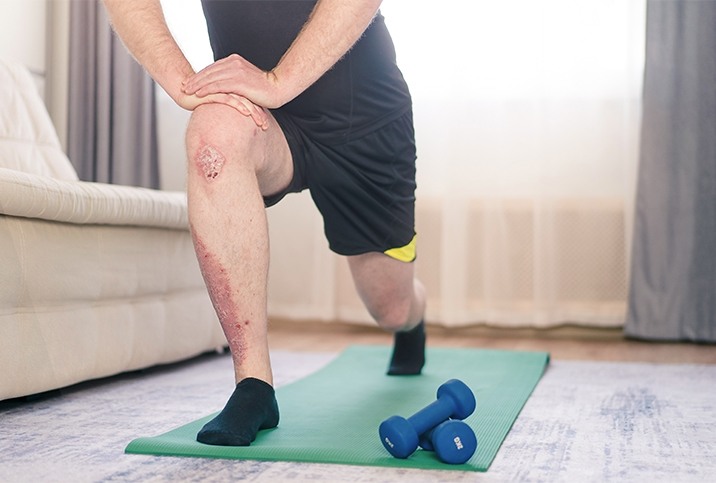What Is It Like to Experience Genital Psoriasis?

More than 7.5 million American adults ages 20 or older have psoriasis, which is about 3 percent of the U.S. population, according to a 2021 study published in JAMA Dermatology. That makes this autoimmune disorder, in which the immune system attacks healthy skin cells by mistake and triggers the body to produce more skin cells, a fairly common condition.
Yet doctors say some forms of psoriasis—genital psoriasis among them—make patients hesitant to seek treatment or speak to their physician.
They shouldn't feel that way, however, according to Marjorie Montanez-Wiscovich, M.D., Ph.D., a clinical assistant professor in the dermatology department at the University of Florida College of Medicine. She encourages her patients to check their shyness at the door when it comes to sharing the places on their body where they're experiencing a psoriasis flare-up.
That includes their genitals.
Psoriasis affects all skin
"Patients usually have multiple locations involved, but they can be reticent to bring rashes in their groin to their doctors," Montanez-Wiscovich said. "I always ask, 'Do you have a rash in your groin area or between the buttocks?' It's quite common, and in many cases, people don't recognize they have it."
If you experience psoriasis on any area of your body, it's more than possible that you have been, or will be, impacted by genital psoriasis, according to Daniel Atkinson, M.B.B.S., who is based in England and serves as the general practitioner clinical lead at online healthcare provider Treated.
"Over half of the people who have psoriasis will experience genital lesions as the condition develops and spreads, which means it can be fairly common to have problems in your sensitive areas if you have psoriasis anywhere else," said Atkinson, who has spent more than a decade practicing medicine and specializing in sexual and reproductive health.
Genital psoriasis can have an effect on your body. Knowing its root causes and the factors that may contribute to a flare-up can help you manage the condition.
What is genital psoriasis?
At its core, genital psoriasis is an autoimmune response of the skin that occurs on or near the genitals. It can appear on a woman's vulva, clitoris and perineum (the area between the genitals and anus) and on a man's penis, scrotum and perineum.
"Due to an overactive immune system, an inflammatory cascade causes the skin to proliferate," Montanez-Wiscovich said. "The skin keeps making more and more skin."
When our bodies produce too many skin cells, it can lead to flaking, scaling and open sores, according to Atkinson.
Two main types of psoriasis can be found in the genitals: inverse psoriasis and plaque psoriasis. Some patients can experience both simultaneously.
Inverse psoriasis is the most common form of genital psoriasis. The term "inverse" refers to psoriasis happening on skinfolds or where skin meets skin. This includes the crease where the thigh begins and the lower abdomen ends, Montanez-Wiscovich said.
This type of psoriasis also tends to appear in the underarms, under the breasts, in the armpits and on the genitalia, Atkinson added.
Dermatologists define plaque psoriasis as a lesion on the body larger than 1 centimeter and raised, Montanez-Wiscovich explained. This type of psoriasis can appear anywhere on the body, including the genitals.
What does genital psoriasis look like?
"With inverse psoriasis, the skin can appear red and tight," Atkinson said. "Plaque psoriasis usually appears red and scaly with a white, sometimes crusty-looking buildup of dead skin."
Montanez-Wiscovich said psoriasis in the genital area can commonly be mistaken for other skin conditions, such as eczema. One facet of its appearance, though, serves as a telltale sign.
"It tends to be a pink to red and raised rash that is well circumscribed, meaning you can tell where the rash starts and ends," she said. "You could think it's eczema, but eczema isn't that well-defined. If you have a well-circumscribed rash in these areas, it's likely to be psoriasis."
Unfortunately, this chronic condition lacks a cure, but that doesn't mean there aren't treatments for genital psoriasis.
"Psoriasis goes through periods when it flares and periods when it disappears or isn't as symptomatic. During a flare, the skin becomes very red and raised. On genital skin, psoriasis can cause skin breakdown if it involves the folds," Montanez-Wiscovich said. "It can make the skin raw or cause fissuring. If your genital psoriasis involves skin on the low abdomen, you might see some scaliness there."
Eventually, as the skin heals, the redness dulls and your skin regains its normal color. The inflammation starts to dissipate and you might see a difference in the color of your skin, similar to a scar. You may experience hypopigmentation, when the skin appears lighter, or hyperpigmentation, when it appears darker.
What does genital psoriasis feel like?
Atkinson said symptoms of genital psoriasis can feel fairly intense due to the thin and sensitive nature of the skin in this area. The four most commonly reported symptoms of genital psoriasis include the following:
- Itching
- Burning
- Pain during intercourse
- Worsening of symptoms following intercourse
Women are more likely than men to report symptoms and negative side effects of their genital psoriasis on their sexual activity, drive and desire, Montanez-Wiscovich said.
What causes genital psoriasis?
All forms of psoriasis are caused by an overactive immune response. The exact reason our bodies behave this way remains somewhat of a mystery, Atkinson explained, but doctors understand quite a bit about the process.
"Psoriasis is caused by new skin cells replacing old ones too quickly. Your body's T-cells attack healthy skin as it grows, perceiving it to be a threat. As the new skin breaks down, it causes inflammation and other psoriasis symptoms," Atkinson said.
T-cells are part of the immune system and develop from stem cells in the bone marrow.
There are some genetic and hereditary risk factors for developing psoriasis, but catching psoriasis from someone who's experiencing symptoms is never a risk—it's not a sexually transmitted infection (STI), according to Montanez-Wiscovich.
"It's important for patients with genital psoriasis to know that they're not contagious. I always tell them, 'You can't transfer this to another person,'" she said. "There are some genetic and hereditary factors, though; psoriasis tends to run in families."
What triggers a genital psoriasis flare-up?
Montanez-Wiscovich and Atkinson agreed on a few common triggers that could cause a flare-up of genital psoriasis lesions and symptoms. Atkinson called them "benign stimulants."
Stress is a significant one. A 2019 study on risk factors that contribute to the development of psoriasis, published in the International Journal of Molecular Sciences, suggested stress has been known to induce flare-ups in many people.
Perhaps not surprisingly, skin injury can induce flare-ups. Flare-triggering injuries to the skin can frequently occur through commonplace activities such as friction, scratching, rubbing, a piercing, a tattoo, cutting the skin while shaving, athletic activities or sex, according to Montanez-Wiscovich.
A bacterial infection, such as a yeast infection, can trigger a genital psoriasis flare, too, she noted. Infections could also occur from exposure to irritants, such as urine, feces and harsh soaps.
Other potential triggers include factors you can control and factors you can't. These include reactions to medications, excessive alcohol consumption, excessive smoking and changes in weather.
The 2019 study referenced above suggested that the risk of flare-ups is higher in people who are obese or have high blood pressure, but more research is needed to fully understand this aspect, Atkinson said.
As an autoimmune condition, psoriasis is not something you can prevent. You can, however, recognize the symptoms of a flare-up and take measures to minimize them. If the condition affects your genitals, take measures to avoid friction, heat and scratching.


















